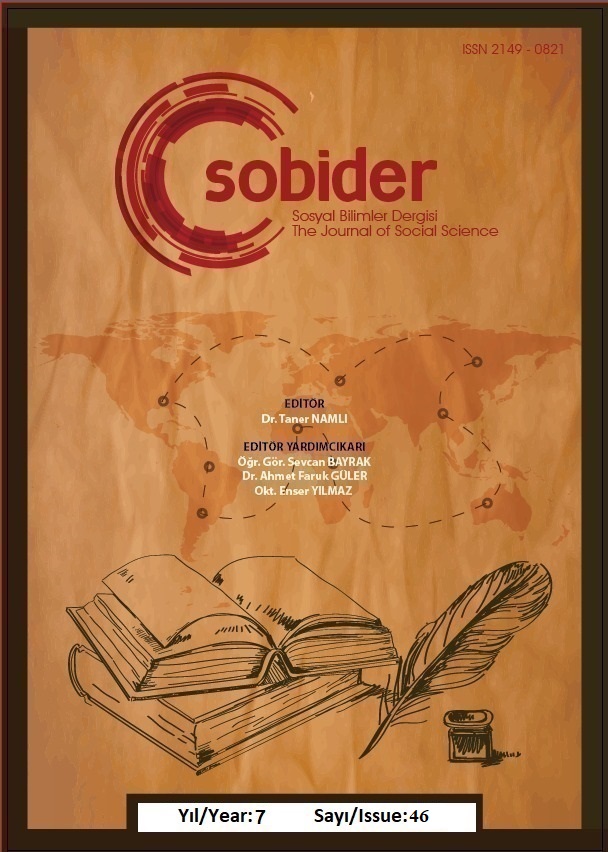Author :
Abstract
Bu çalışmada, araştırma modellerinde kullanılan Aracılık Analizi için uygun olan yöntemin belirlenmesine çalışılmıştır. Bu kapsamda, yaygın olarak kullanılan geleneksel Baron, Kenny Aracılık Analizi yöntemi, sonraki pek çok araştırmacı tarafından eleştirilmiş ve yanlış sonuçlar verebildiği için Aracılık Analizlerinde kullanılmaması gerektiği belirtilmiştir. Modern Aracılık Analizi yaklaşımlarında, Baron, Kenny Aracılık analizinde önerilen Toplam Etkiye odaklanmak yerine, Dolaylı Etkilerin araştırılması gerektiği belirtilmektedir. Bu çalışmada öncelikle geleneksel olarak kullanılan Baron, Kenny Aracılık modelinin özellikleri ortaya konulmuştur. Ayrıca Baron Kenny Aracılık Analizi yöntemine yönelik olarak getirilen eleştiriler, öneriler ve modern yaklaşımlar incelenmiştir.
Keywords
Abstract
In this study, it was aimed to determine the appropriate method for Mediating analysis used in research models. In this context, the widely used traditional Baron, Kenny Mediating analysis method has been criticized by many subsequent researchers and stated that it should not be used in Mediating Analyses because it can yield incorrect results. In modern Mediation analysis approaches, it is stated that indirect effects should be investigated, rather than focusing on the Total Effect proposed in Baron Kenny Mediation analysis. In this study, the characteristics of the Baron Kenny Mediation model traditionally used were revealed. In addition, criticism, suggestions and modern approaches to the Baron Kenny method of Mediation analysis have been examined.
Keywords
- Baron, R. M., & Kenny, D. A. (1986). “The Moderator–Mediator Variable Distinction in Social Psychological Research: Conceptual, Strategic, and Statistical Considerations”. Journal of Personality and Social Psychology, Vol.51, No.6, 1173-1182.
- Eye, A.,V., Mun, E. Y., & Mair, P. (2009). “What Carries A Mediation Process? Configural Analysis of Mediation”. Integrative Psychological and Behavioral Science, Vol.43, No.3, 228-247.
- Fairchild, A. J., & MacKinnon, D. P. (2009). “A General Model for Testing Mediation And Moderation Effects”. Prevention Science, Vol.10, No.2, 87-99.
- Fritz, M. S., & MacKinnon, D. P. (2007). “Required Sample Size to Detect The Mediated Effect”. Psychological Science, Vol.18, No.3, 233-239.
- Hayes, A. F. (2009). “Beyond Baron And Kenny: Statistical Mediation Analysis in The New Millennium”. Communication Monographs, Vol.76, No.4, 408-420.
- Hayes, A. F. (2018). “Introduction To Mediation, Moderation, and Conditional Process Analysis A Regression-Based Approach”. Second Edition, The Guilford Press, New York.
- Hayes, A. F., & Preacher, K. J. (2010). “Quantifying and Testing Indirect Effects in Simple Mediation Models When The Constituent Paths Are Nonlinear”. Multivariate Behavioral Research, Vol.45, No.4, 627-660.
- Hayes, A. F., & Preacher, K. J. (2014). “Statistical Mediation Analysis With A Multicategorical Independent Variable”. British Journal of Mathematical and Statistical Psychology, Vol.67, No.3, 451-470.
- Hayes, A. F., & Rockwood, N. J. (2017). “Regression-Based Statistical Mediation and Moderation Analysis in Clinical Research: Observations, Recommendations and İmplementation”. Behaviour Research And Therapy, Vol.98, 39-57.
- Hayes, A. F., & Scharkow, M. (2013). “The Relative Trustworthiness of Inferential Tests of The Indirect Effect in Statistical Mediation Analysis: Does Method Really Matter?”. Psychological Science, Vol. 24, No.10, 1918-1927.
- Kim, J., Hwang, E., Phillips, M., Jang, S., Kim, J. E., Spence, M. T., & Park, J. (2018). “Mediation Analysis Revisited: Practical Suggestions For Addressing Common Deficiencies”. Australasian Marketing Journal (AMJ), Vol.26, No.1, 59-64.
- MacKinnon, D. P., Coxe, S., & Baraldi, A. N. (2012). “Guidelines for The Investigation of Mediating Variables in Business Research”. Journal of Business and Psychology, Vol.27, No.1, 1-14.
- MacKinnon, D. P. (2011). “Integrating Mediators and Moderators in Research Design”. Research on Social Work Practice, Vol.21, No.6, 675-681.
- MacKinnon, D. P., & Fairchild, A. J. (2009). “Current Directions in Mediation Analysis”. Current Directions in Psychological Science, Vol.18, No.1, 16-20.
- MacKinnon, D. P., & Pirlott, A. G. (2015). “Statistical Approaches for Enhancing Causal İnterpretation of The M To Y Relation in Mediation Analysis”. Personality and Social Psychology Review, Vol. 19, No.1, 30-43.
- Malhotra, M. K., Singhal, C., Shang, G., & Ployhart, R. E. (2014). “A Critical Evaluation of Alternative Methods and Paradigms For Conducting Mediation Analysis in Operations Management Research.” Journal of Operations Management, Vol.32, No.4, 127-137.
- Montoya, A. K., & Hayes, A. F. (2017). “Two-Condition Within-Participant Statistical Mediation Analysis: A Path-Analytic Framework”. Psychological Methods, Vol.22, No.1, 6-27.
- Pirlott, A. G., & MacKinnon, D. P. (2016). “Design Approaches to Experimental Mediation”. Journal of Experimental Social Psychology, Vol.66, 29-38.
- Preacher, K. J., Rucker, D. D., & Hayes, A. F. (2007). “Addressing Moderated Mediation Hypotheses: Theory, Methods, and Prescriptions”. Multivariate Behavioral Research, Vol.42, No.1, 185-227.
- Preacher, K. J., & Hayes, A. F. (2004). “SPSS and SAS Procedures for Estimating Indirect Effects in Simple Mediation Models”. Behavior Research Methods, Instruments, & Computers, Vol.36, No.4, 717-731.
- Preacher, K. J., & Hayes, A. F. (2008). “Asymptotic and Resampling Strategies for Assessing and Comparing Indirect Effects in Multiple Mediator Models”. Behavior Research Methods, Vol. 40, No.3, 879-891.
- Preacher, K. J., & Kelley, K. (2011). “Effect Size Measures for Mediation Models: Quantitative Strategies for Communicating Indirect Effects”. Psychological Methods, Vol.16, No.2, 93-115.
- Rijnhart, J. J., Twisk, J. W., Chinapaw, M. J., de Boer, M. R., & Heymans, M. W. (2017). “Comparison of Methods for the Analysis of Relatively Simple Mediation Models”. Contemporary Clinical Trials Communications, Vol.7, 130-135.
- Rucker, D. D., Preacher, K. J., Tormala, Z. L., & Petty, R. E. (2011). “Mediation Analysis in Social Psychology: Current Practices and New Recommendations”. Social and Personality Psychology Compass, Vol.5, No.6, 359-371.
- Rungtusanatham, M., Miller, J. W., & Boyer, K. K. (2014). “Theorizing, Testing and Concluding for Mediation in SCM Research: Tutorial and Procedural Recommendations”. Journal of Operations Management, Vol.32, No.3, 99-113.
- Shrout, P. E., & Bolger, N. (2002). “Mediation in Experimental and Nonexperimental Studies: New Procedures and Recommendations”. Psychological Methods, Vol.7, No.4, 422445.
- Taylor, A. B., MacKinnon, D. P., & Tein, J. Y. (2008). “Tests of The Three-Path Mediated Effect”. Organizational Research Methods, Vol.11, No.2, 241-269.
- Wu, A. D., & Zumbo, B. D. (2008). “Understanding and Using Mediators and Moderators”. Social Indicators Research, Vol.87, No.3, 367.
